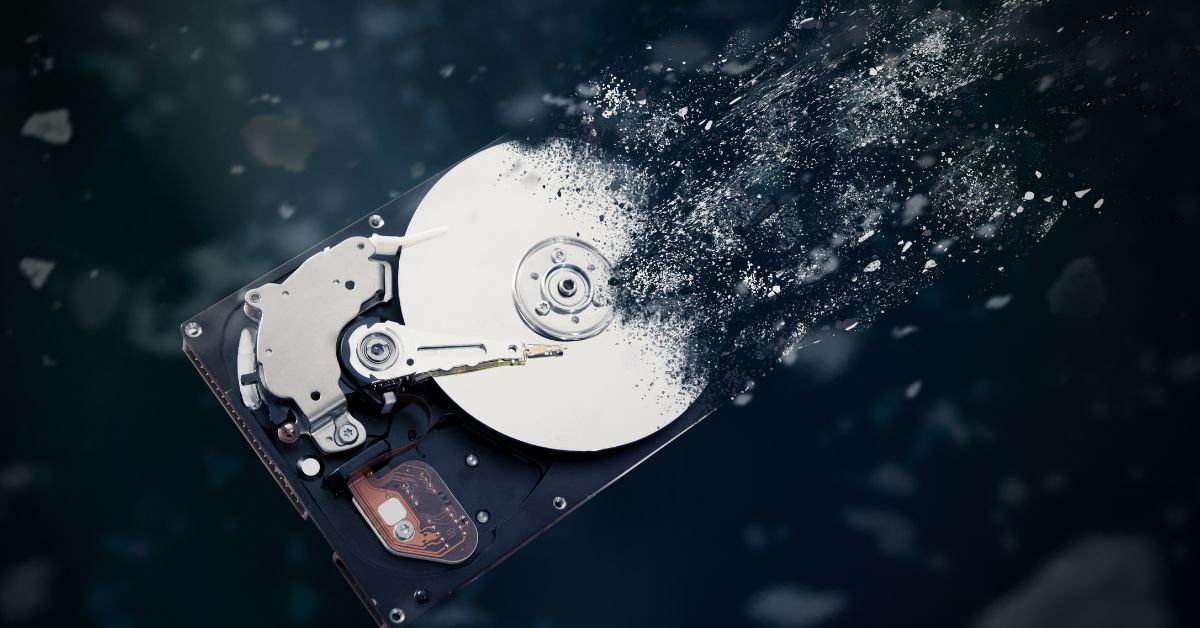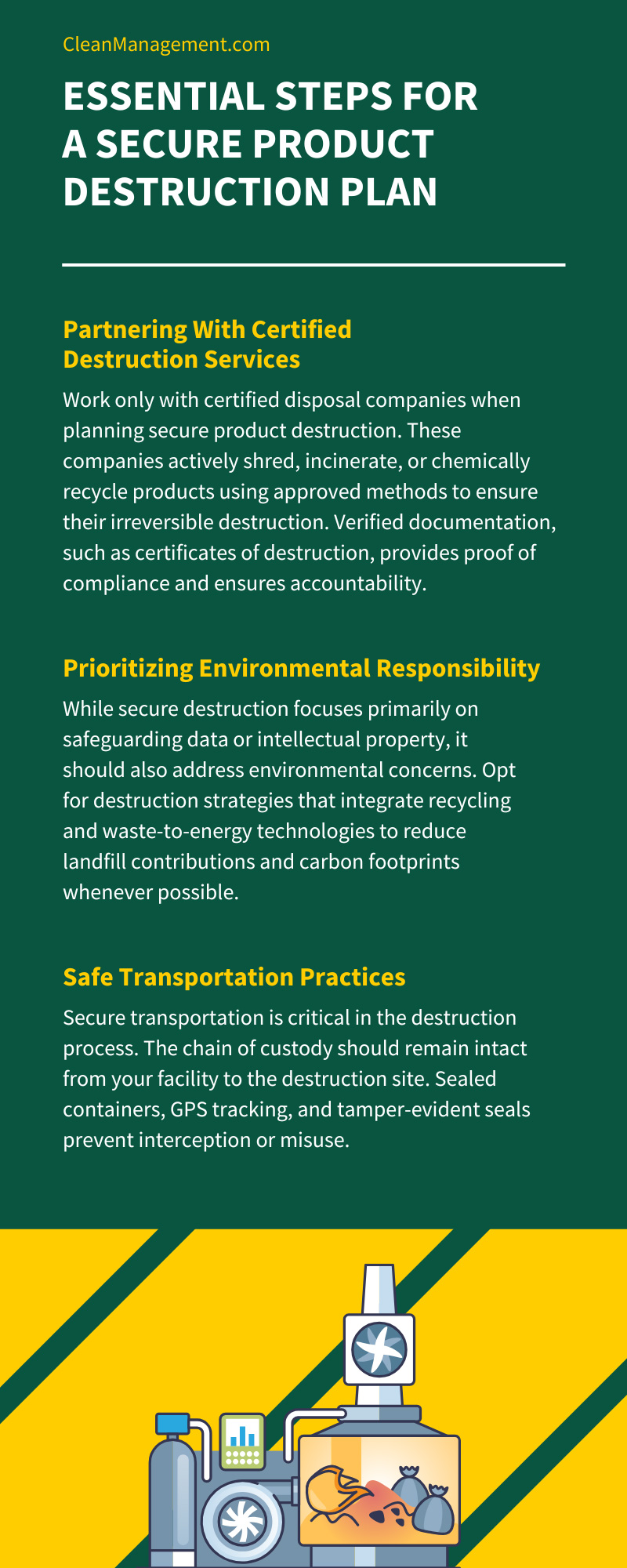Essential Steps for a Secure Product Destruction Plan

Effective product destruction planning involves more than just disposing of unused items. It’s a systematic process to ensure expired, defective, recalled, or unauthorized products do not end up in the wrong hands or compromise your brand’s integrity. Following these essential steps for secure production destruction plan reduces legal and reputational risks and ensures responsible environmental management of your materials.
Understanding Secure Product Destruction
Secure product destruction refers to deliberately disposing of products with specialized methods to ensure their destruction renders them unusable. This process is crucial for businesses concerned with data security, brand protection, and regulatory compliance. Companies in the pharmaceutical, food and beverage, and electronics industries cannot afford to overlook the significance of secure disposal.
For example, after a pharmaceutical company recalls a batch of expired medication, it must prevent the drugs from entering the black market or improper consumption. Therefore, the company must partner with a certified destruction provider. The provider incinerates the recalled products using an approved method, documents the entire process, and issues a certificate of destruction. This approach ensures compliance with health regulations and protects the company’s brand and public safety.
Why Your Business Needs a Product Destruction Plan
A secure product destruction strategy protects your intellectual property, safeguards confidential data, and contributes to consumer trust. The risk of your discarded products resurfacing in unauthorized markets or landfills increases without a clear plan, damaging your reputation and finances.
For example, after an electronics manufacturer develops prototypes for a new device, they follow their secure destruction plan to prevent leaks or counterfeiting. The team collects all outdated units, transports them to a certified facility, and oversees their products’ destruction through shredding and material separation. By executing this plan, the company protects its trade secrets, avoids potential IP theft, and reinforces its commitment to responsible product handling.
Key Considerations for Developing a Secure Destruction Plan
You must first identify the types of products that require secure disposal, which can include expired inventory, defective goods, or items recalled for quality issues. Consider the legal requirements specific to your industry and geographical location, as compliance with secure disposal is non-negotiable.
Partnering With Certified Destruction Services
Work only with certified disposal companies when planning secure product destruction. These companies actively shred, incinerate, or chemically recycle products using approved methods to ensure their irreversible destruction. Verified documentation, such as certificates of destruction, provides proof of compliance and ensures accountability.
Prioritizing Environmental Responsibility
While secure destruction focuses primarily on safeguarding data or intellectual property, it should also address environmental concerns. Opt for destruction strategies that integrate recycling and waste-to-energy technologies to reduce landfill contributions and carbon footprints whenever possible.
For example, electronics companies regularly dispose of outdated hardware. Instead of sending the materials to a landfill, the company can partner with a certified destruction provider that recycles valuable metals and plastics while using waste-to-energy methods for the remaining components. By choosing this environmentally responsible approach, the company protects its intellectual property and significantly reduces its environmental impact.
Safe Transportation Practices
Secure transportation is critical in the destruction process. The chain of custody should remain intact from your facility to the destruction site. Sealed containers, GPS tracking, and tamper-evident seals prevent interception or misuse.
For example, a cosmetics brand needing to dispose of a mislabeled product line can load the products into sealed, tamper-evident containers and hand them off to a certified hauler. The brand can monitor the shipment’s journey to the destruction facility using GPS tracking. Upon arrival, staff can verify the seals and document the transfer, maintaining a clear chain of custody. These secure transportation practices prevent unauthorized access and ensure the products reach their destination without compromise.
Educating Employees
Every employee in your business should understand the importance of the disaster plan. Training programs and regular audits reinforce procedural compliance and equip your team to securely handle products and proprietary information.
Technology for Protected Disposal
Modern technology streamlines secure destruction. Barcode scanning, tracking software, and automated destruction machines provide efficiency and accuracy, ensuring no product skips the process.
For example, a consumer electronics company can use barcode scanning and tracking software to manage the disposal of outdated devices. Staff scan each item into the system, logging the product’s movement from the warehouse to the destruction site. At the facility, automated shredders destroy the devices while cameras record the process for verification. By integrating technology into every step, the company ensures accurate, secure, and fully documented disposal.
Building Consumer Confidence With Transparency
Share your secure product destruction efforts with your audience. Highlighting your commitment to safety and sustainability can foster trust and position your business as a responsible industry leader.
For example, an apparel brand sharing a behind-the-scenes video on its website and social media about how it phases out, shreds, and recycles a defective batch of products reinforces its values, builds consumer trust, and strengthens its reputation as a transparent and ethical company.
Routine Audits of the Destruction Process
Say a medical device company conducts quarterly audits of its destruction procedures. During one review, the audit team discovers inconsistent documentation at a third-party facility. The company immediately updates its reporting requirements, retrains the provider’s staff, and implements a new digital tracking system. By acting on the audit findings, the company closes security gaps, improves compliance, and ensures accountability throughout the destruction process.
Reducing Costs Without Compromising Security
While secure disposal might seem costly, streamlined operations and advanced planning can reduce expenses. Work with service providers offering transparent pricing and evaluate the possibility of waste-to-energy conversion as a cost-effective option.
Consider a food manufacturer who regularly disposes of unsellable inventory. The company can partner with a destruction provider that offers flat-rate pricing and waste-to-energy services to manage costs. Instead of sending materials to a landfill, the provider converts the waste into usable energy. By planning disposal schedules in advance and choosing an efficient service model, the manufacturer reduces expenses while maintaining high security and environmental responsibility.
Choosing the Right Destruction Method for Your Needs
Each industry has unique requirements. Selecting the appropriate destruction method based on the nature of the products ensures complete compliance and added efficacy in safeguarding your brand and consumers.
Secure product destruction planning is essential for maintaining regulatory compliance, protecting intellectual property, and demonstrating environmental responsibility. Building a system that balances security with sustainability shields your business from risks and positively impacts your community and planet. Your organization can elevate its waste management practices to the next level with a structured and informed approach.

